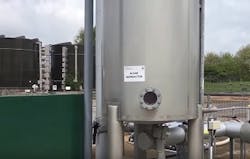VIDEO: Severn Trent trials algal bioreactor for phosphorus removal
PACKINGTON, UK - Utility Severn Trent is beginning to roll out new technologies to remove phosphorus from the sewage treatment process to meet new stringent targets.
The company has been trialling six new technologies at its site in Packington, Leicestershire, to find the best way to reduce the amount of phosphorus from water that is returned to the environment.
The Water Framework Directive regulation requires utilities to meet much tighter phosphorus limits than in the past.
Severn Trent said it hopes to get down to around the 0.1 milligramme per litre level and greatly reduce the amount of phosphorus that goes back into streams and rivers, which can lead to eutrophication.
The technologies being evaluated include: membrane filtration; nano-particle embedded ion exchange; pile cloth media filtration; ballasted coagulation and clarification; immobilised algal bioreactor and absorption media reed beds. Developed by Cranfield University, the ion exchange and algal bioreactor are being put into practical application for the first time.
The pile cloth media filtration is now in place at three sites with plans for four more and the ballasted coagulation and clarification will be installed at two further sites in the near future.
Pete Vale, technical innovation lead from Severn Trent, said: “During the trials we’ve been using some really state-of-the-art techniques to understand which technology will work for our sewage treatment sites that greatly differ in size – from very small local sites to one of the biggest in Europe.”
According to the utility, some of the new technologies have been installed at three plants, with another nine in the planning process.
Vale added: “This is just the beginning of the journey and we’ll be continuing this research to improve our phosphorous removing techniques and provide us with a more sustainable future.”
###
Read/watch more
Nutrient recovery developments
